

The Missionaries - Pre 1870 -
1870 and later.
*(S Rating) Scarcity Rating (includes
scarcity, relevance and content) - with 10 being the most desirable and 1
easiest to acquire. Those highlighted in the deeper shades of red are highly
sought after works.


 Sermons Preached in London, at the Formation of the Missionary Society, 1795 -
Sermons Preached in London, at the Formation of the Missionary Society, 1795 -The 246 page hardcovered A5-sized book carries a list of subscribers to its publication - less than 200 copies, making this an extremely rare work today. Interestingly Rev John Campbell played no part in its formation.
This historic book carries sermons preached in London at the formation of the London Missionary Society from 22nd to 24th September 1795. In the opening pages it sets out the strategy for the formation of the London Missionary Society (pages copied in images below).
The book is the foundation stone of the Griqua name as Rev John Campbell came to Klaarwater in 1813 on the instruction of the LMS and changed their name from bastards to Griqua.
The sole object of the LMS in "The Plan" (see scans below) is... to spread the knowledge of Christ among heathen and other unenlightened nations
The book is in excellent condition, apart from some spotted foxing, in original black leather with marbled boards and gilt on spine. The publisher is Barrett and Marsh of Newburyport.
The Appleton Library is the pastor's library of the First Congregational Church of North Brookfield, Massachusetts. All of these books are from that library and bear the historic Appleton Library bookplate on the inside cover (see image below).
The Balson Holdings Family Trust holds the volume withdrawn from The Appleton Library.
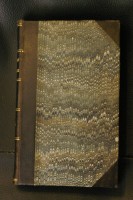 |
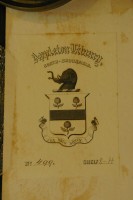 |
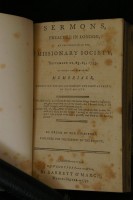 |
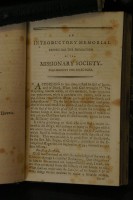 |
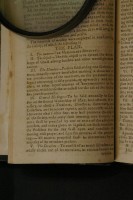 |
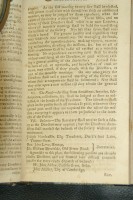 |
| guidelines (The Plan) |
Critical comment on this work:More on the importance of the London Missionary Society on the Griqua heritage can be seen at this link This book was purchased in June 2009 on eBay through Sally Fiske of The Appleton Library with a reserve of US$1,000.. the many books sold carried this common statement: The Appleton Library is the pastor's library of the First Congregational Church of North Brookfield, Massachusetts. In an attempt to modernize the Library to better serve the current pastors, a number of volumes from the Library are being offered for sale. Nearly all of the books are in excellent condition, with the historic Appleton Library bookplate on the inside cover being the only indication of the books' origin. |

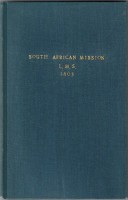 South African Mission - London Missionary Society
- 1803
South African Mission - London Missionary Society
- 1803[Kircherer (Van der Kemp)] London Missionary Society. South African Mission, (being pages 323-508 of the Transactions of the Society Vol I, from its institution in the year 1795 to the year 1802 ...). . Bye and Law, London. (1803) 8vo., [323-508]pp., recently bound in new blue cloth gilt. Very good. An extremely rare work.
This comprises the complete section on Southern Africa, and from the pagination would appear to be the first edition. Mendelssohn (I,921) only cites the British Museum Copy of the second edition and comments "... (contains) an account of the Revs. Kircherer and Kramer in connection with their mission to the Bushman, and of William Anderson's Mission to the Corannas and Bastards. There is also a narrative. of Dr. Vanderkemp's conversion and call to to missionary work ...".
Also see SABib 3, 156. Listing only one copy of the first edition.
The Balson Holdings Family Trust holds this volume in very good condition.
The Frontispiece |
One of the first translations of |
Critical comment on this work:A fabulously rare work including first hand accounts by the first missionaries to live with the Griquas |

 Evangelical Magazine Vol XIII - 1805
Evangelical Magazine Vol XIII - 1805
There are over 600 pages pages in this 1805 yearbook of The Evangelical Magazine. There is no torn or damaged text pages in this volume. There is light between the front board and the binding - the back board is okay. The bluish marbled boards are half calf - the backstrip is rubbed and scuffed and beginning to peel at both top and bottom. The text block looks good and is attached. The book's dimensions are 5.75 x 8.75 inches and the thickness of the book measures 1.75 inches.
On page 86 of the book is the report on the remarkable conversion of Cupido to Christianity.
It reads: The following remarkable account of the conversion of Cupido, a Hottentot, is taken from No XII of the Missionary Transactions - just published. The image of Cupido shown below is carried in a later edition of the evangelical society's yearbook.
The article refers to Cupido being a drunk before his conversion - which apparently resulted in miraculous changes in his life and behaviour.
The Balson Holdings Family Trust holds this volume in very good condition.
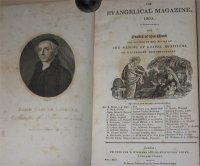 |
|
Cupido |
Front of book |
Critical comment on this work:Largely covers unrelated mission work but carries useful info on the Hottentot |
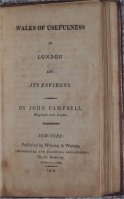 This
(second edition) small book just 136 pages long and measuring only 9cm by
14cm gives an extraordinary insight into the man, John Campbell. (See
also Campbell's 1811
letter about the reprint of this book)
This
(second edition) small book just 136 pages long and measuring only 9cm by
14cm gives an extraordinary insight into the man, John Campbell. (See
also Campbell's 1811
letter about the reprint of this book)
The book records many of Campbell's experiences in meeting fellow Londoners in the early 1800s and how he allegedly took (for example) a woman skinning a live eel to task saying "how would you like to be skinned alive"... and allegedly asking a banker if he has any bills drawn on heaven the most civilised country in the world.
I say allegedly because in his introduction Campbell says, Though I have presented these Walks of Usefulness to the public , I have to confess, with shame, that they describe in many instances, what might have been done, rather than what, in many cases, I have really done. He also reflects on his future missionary life by saying "If every Christian were to consider himself a missionary from God to such perishing men as he has access to, which he certainly is, much good might be done every day...."
A copy of the 1812 and 1813 edition is in the Balson Holdings Family Trust collection.
A summary of John Campbell's life can be seen at this link
Critical comment on this work:This book gives an amazing insight into the mind of John Campbell - a man with big ideas but very little substance to make them happen. When one reads this book in the light of his confessions made at the introduction it casts a completely new light on his strength to follow through with issuing money for the Griquas in 1815. |


 The first edition book of
this book, shown right, has page 250 incorrectly marked as 450 and was
"Printed for the author by Black and Parry in 1815" and "sold by
the author at his house in Shacklewell near Kingsland at the Missionary Society
Rooms". The Balson Holdings Family Trust holds two copies of this
extremely rare book as well as a copy of the more common second edition,
"Printed for Black, Parry and Co in London in 1815 with corrections."
Included in these corrections is the correct numbering of page 250.
The first edition book of
this book, shown right, has page 250 incorrectly marked as 450 and was
"Printed for the author by Black and Parry in 1815" and "sold by
the author at his house in Shacklewell near Kingsland at the Missionary Society
Rooms". The Balson Holdings Family Trust holds two copies of this
extremely rare book as well as a copy of the more common second edition,
"Printed for Black, Parry and Co in London in 1815 with corrections."
Included in these corrections is the correct numbering of page 250.
The book is a transcript of John Campbell's journal's following his first visit (1813). His visit was prompted by the death of the Missionary Society of London's lead man in South Africa. Campbell was sent out to inspect the state of the missions and make recommendations for the future. Campbell toured the country, meeting not only the natives, but the Boer settlers, of whom he a had a very poor opinion. Near Graaff-Reinet, the party met the celebrated traveller/explorer, Burchell and later on they journeyed through the Snewburg and "Bushmen's Country"until they reached Klaar Water (home of the Bastards/Griquas), from which place they pushed on for Lattakoo where they made the acquaintance of the king, "Mateebe", and there is an interesting account of the King and his people. Much information with regard to past events involving the party of Dr. Cowan massacred years earlier and the countries beyond Lattakoo was obtained from the King. (Reprint copy also held - see below)
His accounts of Africa in this book are said to have influenced Dr Livingstone to travel to S Africa.
It is in this book the immortal, but misleading words are penned (pg 256):
"It was likewise resolved that as they had no circulating medium amongst them by which they could purchase any small article, such as knives, scissars (sic) etc, etc. supposing a shop to be established amongst them - which they were anxious there should be - they should apply to the (London) Missionary Society to get silver pieces of different value coined for them in England, which the Missionaries would take for their allowance from the Society, having the name of Griqua town marked on them. It is probable that if this were adopted in a short time they would circulate amongst all the nations about, and be a great convenience".
The introduction of this book (pg vii) states that it reflects a transcript of Campbell's journal - now this is an important. Campbell's later abridged book of the same trip (see item below) makes absolutely no reference to the minting of coinage (see para above).
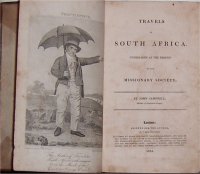 Balson also argues that the Griqua Town coins
that Campbell refers to in his 1815 book were eventually
minted as token coins in about 1820 but never circulated.
Balson also argues that the Griqua Town coins
that Campbell refers to in his 1815 book were eventually
minted as token coins in about 1820 but never circulated.
Some of the logic is quite simple, not only were the Griquas unable to count (they could not even write) but they had had no store to trade them in Griqua Town. Campbell's lack of reference to them in his second book Travels in S Africa, a second journey (published 1822) when he re-visited the griquas reveals the failure of his earlier diary notes. Finally, consider the relative scarcity of all pieces "IIIII", 10, 1/4 and1/2 - pointing to a small trial mintage not a mintage of coins to be used by a community... after all it takes thirty to fifty 1/4 pieces to make up the change for a "IIIII" or 10.
Image right: Frontpiece of this first edition book
Copies of this rare and valuable first edition book with original maps, in very good condition, with slight discolouration on some pages and damage to the outside rib and a second edition copy with extensive foxing are held in the Balson Holdings Family Trust collection.
Critical comment on this work:The comments on page 256 of Campbell's transcribed journals is at the very heart of the misconception that the Griqua Town coins (note in all Campbell's books he refers to "Griqua Town" as two words - not one as shown on the coins) were South Africa's first circulating currency. The 1815 review of this book reflects the fantasy on which much of this book is based. |


Somewhat scathing treatment of the Reverend John Campbell's book: "Travels in South Africa, undertaken at the Request of the Missionary Society" (1815 displayed above) and his role as missionary at the Cape of Good Hope. Reflects the claims that Campbell could not be trusted in his writings because he could not discern between fact or fantasy... this claim is supported by none other than Rev Robert Moffat - more at this link.
Excerpt from the text:
"Another objection to the choice of Mr. Campbell is the evident absence of every qualification with which, in these days, a traveller is expected to be gifted. The most common objects of nature he is either unacquainted with, or affects to consider as beneath his notice; and the reader who looks for information as to the natural history or the geography of that part of south Africa, hitherto but little travelled by Europeans , will meet with disappointment; false nomenclature, and vague and confused description, are all he is to expect."
Replete with Campbell's quotes and interactions with the unconverted Hottentots, Booshuanas, Namaquas and Coranas as he journeys via New Drosdy of George Town, Bethelsdorp, easterly to Albany, onto Graaf Reynet, Sneuwberg, Leetakoo, etc., and finally returns to the Cape of Good Hope after an absence of nearly nine months.
Below are examples of the reviewers comments (click on thumbnail) questioning the integrity of Campbell's writing....
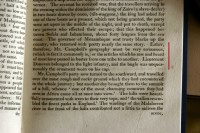 |
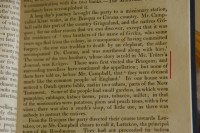 |
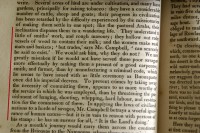 |
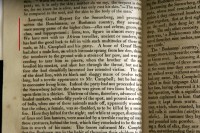 |
The Balson Holdings Family Trust holds this extremely rare 22 page review in very good condition
Critical comment on this work:Reflects the growing understanding that many of Campbell's claims were nothing more than fantasy |

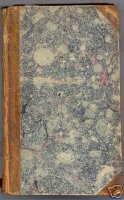 Evangelical Magazine - Missionary Chronicle Vol XXIV
(1816)
Evangelical Magazine - Missionary Chronicle Vol XXIV
(1816)
There are 530 pages in Volume XXIV of The Evangelical Magazine for the year 1816. There is no torn or damaged text pages in this volume, although there is offset from the engraving for each month and foxing throughout. There is light between the front board and the binding - the back board is okay. The bluish marbled boards are half calf - the backstrip is rubbed and scuffed and beginning to peel at both top and bottom. The text block looks good and is attached. The book's dimensions are 5.75 x 8.75 inches and the thickness of the book measures 1.50 inches.
The first engraving in the book is of Cupido - Hottentot Evangelist. There is an engraving at the beginning of each month - some of the people from these engravings are: The Revs. Mark Wilks from London, Rich Herdsman of L. Petherton, Somerset, and Ebenezer Chandler, immediate successor to the Rev. John Bunyan as the pastor of the church of Protestant Dissenters, Bedford.
There are many letters by the Rev Read who stayed with the Hottentots in Namaqualand - one refers to Cupido (see image below) who he calls an evangelist. A report on Cupido's conversion is carried in an earlier release of this evangelical book (1805). There are no other known references to this elusive Hottentot evangelist.
Read refers extensively to the conversion of the much feared Jager Africaner - an event which only took place years later.
The Balson Holdings Family Trust holds this volume in very good condition.
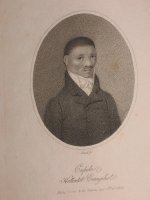
Cupido the elusive Hottentot evangelist
Critical comment on this work:Largely covers unrelated mission work but carries useful info on the Hottentot |
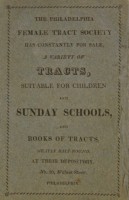
 The first edition, soft covered book of
this small 52 page booklet is attributed to Rev John Campbell (the first title "History of Peter Patience" is
attributed to Kiah Bayley, a Massachusetts minister).
The first edition, soft covered book of
this small 52 page booklet is attributed to Rev John Campbell (the first title "History of Peter Patience" is
attributed to Kiah Bayley, a Massachusetts minister).
The small booklet was published by the Philadelphia Female Tract Society and only sold at their depository at 20 Walnut St. The printer was one of their number, Lydia R Bailey. The book demonstrates Rev John Campbell's pioneering role in creating religious tracts after he became a Director of the London Missionary Society.
The Balson Holdings Family Trust also holds an extremely rare hard copy of the book with the titles "The Pleasures of Piety in Youth" (by Kiah Bayley) and "Worlds Displayed" (by John Campbell).
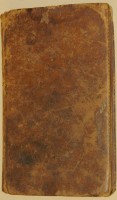 The hard copy edition - image of cover right holds the two books and has about 120 pages.
The hard copy edition - image of cover right holds the two books and has about 120 pages.
The book has a fair amount of browning but is otherwise in excellent condition.
Some of the graphics and main pages of the hard covered book are scanned below.
Other titles attributed to Rev John Campbell include: "History of Fanny Faithful"; "History of a Jewish Convert"; "Visits to Souls in prison"; "History of Methusa"; "History of Haman" and "History of Sophia".
This is possibly the first bible tract ever published in this manner, being the father of all the weekly and daily bible tracts that are found in so many forms today.
It is extremely rare today and rarely seen for sale.
The Balson Holdings Family Trust holds copies of both these rare books in excellent condition. They cannot be found for sale on the Internet.
Shown below are the back cover and frontispiece of the soft cover edition:
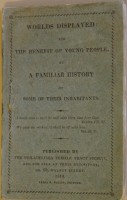
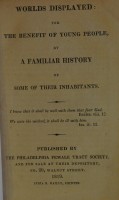
Shown below are scans from the hardcover edition:
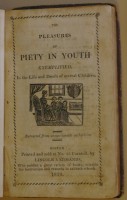
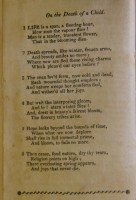
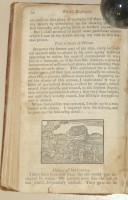
Critical comment on this work:A historically significant chapter in the spreading of the word by Missionaries and religious groups that predates all the other missionary tracts shown on this page. |

 Travels
in South Africa.. a second journey (published 1822) - Rev John
Campbell
Travels
in South Africa.. a second journey (published 1822) - Rev John
CampbellFull title: "Travels in South Africa, undertaken at the request of the London Missionary Society; being a narrative of a second journey in the interior of that country".
This very rare first edition (London) set of two books is an account of Campbell's travels among the various tribes of the northern Cape Colony and into Bechuanaland (Botswana), including the Griqua, Bushmen, Coranna and Tswana. There are two volumes, pp. viii,xii,322 + (iii),384,(i), 12 hand-coloured plates, folding colour map. Much of the trip was undertaken with the young Robert Moffat who was later stationed at a new missionary centre at Kuruman.
The book has its original contemporary full-leather, recased with original gilt backstrips laid on, new end-papers. The spine & hinges are rubbed and the map (commonly) repaired at the folds. This is an attractive set of the large paper edition (24cm tall) with just some foxing.
There is a condensed version of this book published in 1830.
The Balson Holdings Family Trust holds this set of the two volumes in very good condition.
Critical comment on this work:It is Robert Moffat's less than flattering comments about John Campbell that make this book so intriguing. Moffat, who travelled with Campbell during his second trip, refers to Campbell's weakness for liquor and his foul mouth at these times. This side of Campbell, hidden in the books published by both missionaries is revealed in Moffat's letters published in the book Apprenticeship at Kuruman. Interestingly Campbell makes no reference to the "Griqua Town coins" in this book (see his book above) - an extraordinary oversight for a man who goes into so much detail about other aspects of Griqua life. The 1822 review of this book reflects the fantasy on which much of this book is based. |

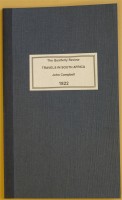 The Quarterly Review -
Travel in South Africa, a second journey (1822)
The Quarterly Review -
Travel in South Africa, a second journey (1822)
A contemporary analysis on Campbell's second trip, which was published the same year (1822 displayed above). A review decidedly derisory in tone describes Campbell's work as "desultory" and Campbell himself "indifferently qualified" for the task. The breadth of subject matter is wide and the account of London Society Missions complete. The author is accused, however, of simplicity and credulity in his descriptions which include the "peculiarities" of the Booshuana and their practice of infanticide, negligence toward elders, circumcision, the role of the Rain Makers; the Peetsos; king of the Mashows; the Kurreechanes and more.
The Balson Holdings Family Trust holds this extremely rare 14 page review in very good condition
Critical comment on this work:Reflects the growing understanding that many of Campbell's claims were nothing more than fantasy |

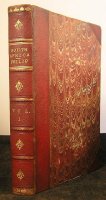 Researches in South Africa (published 1828) - Rev
John Philip
Researches in South Africa (published 1828) - Rev
John PhilipFull title: "Researches in South Africa; illustrating the civil, moral and religious conditions of the Native Tribes: Including Journals of the author's travels in the interior; together with detailed accounts fo the progress of the Christian Missions, exhibiting the influence of Christianity in promoting civilization".
This very rare first edition Volume One (of two volumes) book was published in 1828 by James Duncan. The book in verg good clean and tight condition with period leather bindging, raised bands and gilt stamps.
Volume two of the book is in the Balson Holding Family Trust's digital library - the entire book can be viewed through Google Books at this link..
The two 1828 volumes, when available, sell for over US$1000.
The Balson Holdings Family Trust holds volume one of this extremely rare book in very good plus condition.
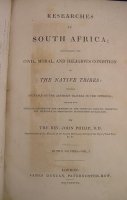 |
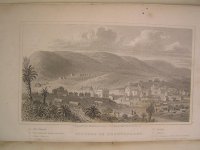 |
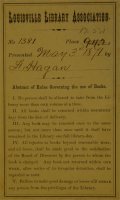 |
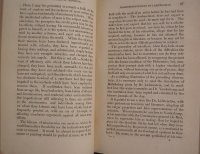 |
Critical comment on this work:Philip accompanied Rev John Campbell on his second trip to South Africa - having been in the country from the early 1810s. In Volume Two of his book he quotes the London Missionary Society's William Anderson verbatim at length. Anderson making no reference AT ANY TIME to the "Griquatown coins" (pg 57-62). This evidence can be seen by going to Google Books at this link, searching on "Anderson" - a quick-loading transript of the relevant piece can be seen at this link. |

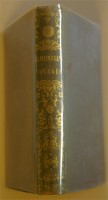 Voyages to and
from the Cape of Good Hope with an account of a journey into the interior
of S Africa by Rev John Campbell
(1830)
Voyages to and
from the Cape of Good Hope with an account of a journey into the interior
of S Africa by Rev John Campbell
(1830)
Published for the Religious Tract Society, this 271 page book with several illustrations (some shown below) has a blind stamped cloth and gilt spine. (The rare 248 page 1840 edition of this book can be seen below)
This 16cm by 10cm sized book is a condensed description of his second voyage to S. Africa, 1819-21 and is "intended for the young". The full account of his second voyage appeared in 2 vols. in 1822.
Publisher: Philadelphia: Presbyterian Board of Publication
Two copies of this extremely rare books in very good and fair condition are held in the Balson Holdings Family Trust collection. (No copies of this books are available for sale on the Internet).
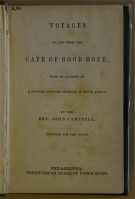 |
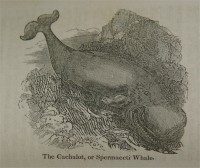 |
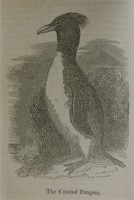 |
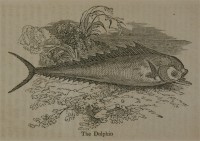 |
Frontispiece |
Whale |
Penguin |
Dolphin? |
Critical comment on this work:A fascinating, fanciful but rare edited work of Campbell's second trip to South Africa. |
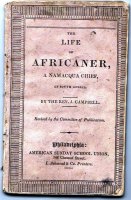 The Life Of Africaner, A Namacqua Chief, Of South Africa
The Life Of Africaner, A Namacqua Chief, Of South Africa
by the Rev. J. Campbell
(1831, 1833 and
1837)
Published in Philadelphia by the American Sunday School Union. (Soft covered 1831 first edition seen right)
Softcover/Hardcover. Small, 13cm by 8cm. Pages vary on editions.
The Juvenile Cabinet of Publications with this issue concerning the Hottentot brigand, Jager Africaner, who attacked Boers and other natives before converting to Christianity (26 pages). There is an additional 9 page tract entitled "Happy Death of a Madagascar Youth". It is illustrated with wood engravings.
Three copies of this extremely rare book, one with a soft (1831) and two with a hard cover (1833 and 1837), all with slight discolouration on some pages are held in the Balson Holdings Family Trust collection.
1831: 55 pages
1833: 48 pages
1837: 48 pages
The purchase of multiple copies of this book, like Dower, is made by the trust because of its extreme, but unrecognised, rarity. You cannot buy these books anywhere today and just a handful remain in existence.
No copies remain for sale on the Internet. It is believed that the soft covered 1831 first edition is unique.
The more common, later hard copy editions of this book attracts amazing interest and realises amazing prices in 2008... more at this link!
More on this book at this link.
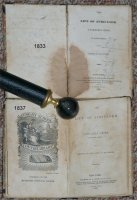 |
|
|
| 1831 soft cover edition | 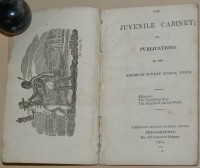 |
These extremely rare books are held in the Balson Holdings Family Trust
collection.
Critical comment on this work:A fascinating but somewhat biased insight by Campbell into the life of this reformed bandit |

 Voyages to and from the Cape of Good Hope with
an account of a journey into the interior of S Africa by Rev John Campbell
(1832)
Voyages to and from the Cape of Good Hope with
an account of a journey into the interior of S Africa by Rev John Campbell
(1832)
Published for the Religious Tract Society, this second edition 248 page book with several illustrations (some shown below) has a cloth spine and stamped "Worcester National School Library" (see below).
This 16cm by 10cm sized book is a condensed description of his second voyage to S. Africa, 1819-21 and is "intended for the young". The full account of his second voyage appeared in 2 vols. in 1822.
Publisher: Philadelphia: Presbyterian Board of Publication
One copy of this extremely rare book in fair condition is held in the Balson Holdings Family Trust collection. (No copies of this books are available for sale on the Internet).
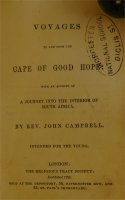 |
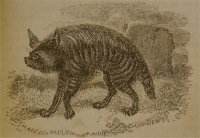 |
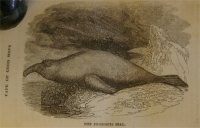 |
|
Frontispiece |
Hyena |
Seal |
|
Critical comment on this work:A fascinating, fanciful but rare edited work of Campbell's second trip to South Africa. |
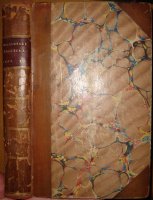 London Missionary Society Magazine
London Missionary Society Magazine
by Various
(1832)
The Missionary Magazine and Chronicle hardbound; Relating Chiefly to the Missions of the London Missionary Society. 1839, 1840, and 1841 all separately paginated and complete. Incorporation June - December 1839, January to December 1840, and January to December 1841.
There are many plates in the book.
Contents include:
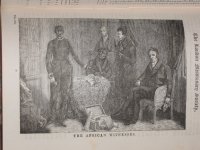
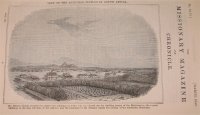
Critical comment on this work:A fascinating and rare work by the London Missionary Society - with a special interest in Robert Moffat's address. |

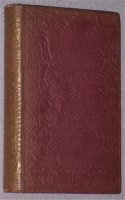 This fascinating
234 page work (without any maps) is a concise version of Campbell's earlier
"Travels in South Africa". In this work Campbell
summarises much of his trip while keeping in all the important and relevant
pieces. The book was written by Campbell twenty years after his first visit,
and nearly the same period after his published work based on the journals
of his first trip were published. With this in mind it is clear that
Campbell would have had plenty of time to reflect on the fact and
fantasy reflected in the journals of his first trip.
This fascinating
234 page work (without any maps) is a concise version of Campbell's earlier
"Travels in South Africa". In this work Campbell
summarises much of his trip while keeping in all the important and relevant
pieces. The book was written by Campbell twenty years after his first visit,
and nearly the same period after his published work based on the journals
of his first trip were published. With this in mind it is clear that
Campbell would have had plenty of time to reflect on the fact and
fantasy reflected in the journals of his first trip.
This extremely important and rare book, just six inches high by four inches across, has the same frontpiece image as the 1815 work but reflects the important variation from transcript of his journal to "abridged by the author". (This book is in fact far rarer than the earlier published works on his travels).
The context of the pages dealing with August 7th, the date Campbell had the historic meeting with the Griquas - at which time their name was changed - is perfectly summarised in this abridged version with one very significant point of difference.
NO REFERENCE TO ANY DISCUSSION WITH THE GRIQUAS ABOUT MINTING COINS THROUGH THE LONDON MISSIONARY SOCIETY.
Image right below: Frontpiece of the abridged "Journal of Travels in South Africa" carries the same image and similar format as the earlier (1815) transcribed journal of his travels. First edition (1834) undated on this page.
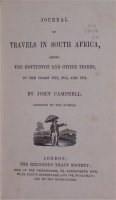 In
fact, the paragraph transcribed in the 1815 work at this
link is totally omitted by Campbell and is replaced by a subject
not covered in this earlier work. Campbell says, on pages 174 and 175:
In
fact, the paragraph transcribed in the 1815 work at this
link is totally omitted by Campbell and is replaced by a subject
not covered in this earlier work. Campbell says, on pages 174 and 175:
Many of the people have gardens; tobacco holds a distinguished place in them. It evidently is the favoured plant. Many acres of land in different parts of the country, especially around Griqua Town are cultivated. They abound in horned cattle, sheep and goats; and these, with other outward comforts, the people acknowledge, have considerably increased since they became a stationery people.
and
Regular trades cannot be said yet to exist in Griqualand.
The first paragraph discusses the basic level of farming that the Griquas had attained. The second statement is a reality check that flies in the face of the grandois ideals of minting coins - as transcribed from his journals in "Travels in South Africa". In fact it screams out as an admission by Campbell of his reporting fantasy as opposed to recording fact. This first edition edit by Campbell OMITS any reference to the Griquatown Coins. As reflected above and noted below Campbell was, by his own admission, a man who wrote with fervour - but often created an ideal in his writing without actually bringing it to fruition.
Though I have presented these Walks of Usefulness to the public , I have to confess, with shame, that they describe in many instances, what might have been done, rather than what, in many cases, I have really done.
NOTE: A transcript of the relevant pages of "Journal of Travel in South Africa" together with digital mages of the relevant pages can be seen at this link.
Three copies of this extremely rare and valuable 1834 edition of the book, with slight discolouration on some pages is held in the Balson Holdings Family Trust collection.
Critical comment on this work:Campbell's omission in this work abridged by him of any reference to discussions with the Griquas about minting coins and his comment, in its place that Regular trades cannot be said yet to exist in Griqualand spells out the fantasy of what he wrote in the transcribed journals in his earlier work. |
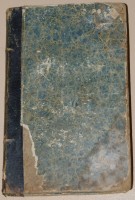

Journey to Lattakoo in South Africa
by Rev John Campbell (1834)
Like Campbell's fascinating fifth edition 1834 work "Journal of travels to South Africa" which exposes his "Griquatown Coin" furphy this small (15cm by 10cm) 204 page book looks at a specific part of his trip to Lattakoo covered in his earlier book about his second trip to South Africa.
The book carries a short piece about Griquatown where Campbell experienced a total eclipse of the sun at 4pm on the 14th March 1820. Campbell also talks about the death at this time of eight Griqua through a lightening strike at the small settlement of Hardcastle.
It is in this book that Campbell goes into graphic detail (pp 187) about a fight that allegedly took place between Dam Kok and a large lion when the beast had put a small bushman kraal under siege. The humanitarian theme was not lost on Dr Philip who later granted Dam Kok the ownership of the lands now known as the Orange Free State. Of course the bushmen were the Griqua's enemy ... and Philip had become an accomplice in their extermination through his actions.
Critical comment on this work:A fascinating and rare work by the missionaries - the lion story fills in a missing piece of the jigsaw as to why Dr Philip gave the bushmen over to the Griqua. |
Journal of Travels in South
Africa - abridged by Rev John Campbell
(1835)
- Rev John Campbell

 This
fascinating 228 page second edition work (without any maps) is a concise
version of Campbell's earlier "Travels in South
Africa". In this work Campbell summarises much of his trip while
keeping in all the important and relevant pieces. The book was written by
Campbell twenty years after his first visit, and nearly the same period after
his published work based on the journals of his first trip were published.
With this in mind it is clear that Campbell would have had plenty of time
to reflect on the fact and fantasy reflected in the journals of his first
trip.
This
fascinating 228 page second edition work (without any maps) is a concise
version of Campbell's earlier "Travels in South
Africa". In this work Campbell summarises much of his trip while
keeping in all the important and relevant pieces. The book was written by
Campbell twenty years after his first visit, and nearly the same period after
his published work based on the journals of his first trip were published.
With this in mind it is clear that Campbell would have had plenty of time
to reflect on the fact and fantasy reflected in the journals of his first
trip.
This extremely important and rare book, just six inches high by four inches across, has the same frontpiece image as the 1815 work but reflects the important variation from transcript of his journal to "abridged by the author". (This book is rarer than the the 1834 first edition and earlier published works on his travels).
The context of the pages dealing with August 7th, the date Campbell had the historic meeting with the Griquas - at which time their name was changed - is perfectly summarised in this abridged version with one very significant point of difference.
NO REFERENCE TO ANY DISCUSSION WITH THE GRIQUAS ABOUT MINTING COINS THROUGH THE LONDON MISSIONARY SOCIETY.
Image right below: Frontpiece of the abridged "Journal of Travels in South Africa" carries the same image and similar format as the earlier (1815) transcribed journal of his travels. Second edition (1835) dated on this page.
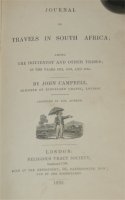 In
fact, the paragraph transcribed in the 1815 work at this
link is totally omitted by Campbell and is replaced by a subject
not covered in this earlier work. Campbell says, on pages 167 and 168:
In
fact, the paragraph transcribed in the 1815 work at this
link is totally omitted by Campbell and is replaced by a subject
not covered in this earlier work. Campbell says, on pages 167 and 168:
Many of the people have gardens; tobacco holds a distinguished place in them. It evidently is the favoured plant. Many acres of land in different parts of the country, especially around Griqua Town are cultivated. They abound in horned cattle, sheep and goats; and these, with other outward comforts, the people acknowledge, have considerably increased since they became a stationery people.
and
Regular trades cannot be said yet to exist in Griqualand.
The first paragraph discusses the basic level of farming that the Griquas had attained. The second statement is a reality check that flies in the face of the grandois ideals of minting coins - as transcribed from his journals in "Travels in South Africa". In fact it screams out as an admission by Campbell of his reporting fantasy as opposed to recording fact. This revised second edition again OMITS any reference to the Griquatown Coins. As reflected above and noted below Campbell was, by his own admission, a man who wrote with fervour - but often created an ideal in his writing without actually bringing it to fruition.
Though I have presented these Walks of Usefulness to the public , I have to confess, with shame, that they describe in many instances, what might have been done, rather than what, in many cases, I have really done.
NOTE: A transcript of the relevant pages of "Journal of Travel in South Africa" together with digital mages of the relevant pages can be seen at this link.
A single copy of this extremely rare and valuable book, with slight discolouration on some pages is held in the Balson Holdings Family Trust collection.
Critical comment on this work:Campbell's omission in this work abridged by him of any reference to discussions with the Griquas about minting coins and his comment, in its place that Regular trades cannot be said yet to exist in Griqualand spells out the fantasy of what he wrote in the transcribed journals in his earlier work. |
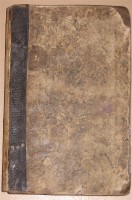

Journey to Lattakoo in South Africa
by Rev John Campbell (1835)
Like Campbell's fascinating second print, 1835, work "Journal of travels to South Africa" this small (15cm by 10cm) 207 page revised book looks at a specific part of his trip to Lattakoo covered in his earlier book about his second trip to South Africa.
The book carries a short piece about Griquatown where Campbell experienced a total eclipse of the sun at 4pm on the 14th March 1820. Campbell also talks about the death at this time of eight Griqua through a lightening strike at the small settlement of Hardcastle.
It is in this book that Campbell goes into graphic detail (pp 187) about a fight that allegedly took place between Dam Kok and a large lion when the beast had put a small bushman kraal under siege. The humanitarian theme was not lost on Dr Philip who later granted Dam Kok the ownership of the lands now known as the Orange Free State. Of course the bushmen were the Griqua's enemy ... and Philip had become an accomplice in their extermination through his actions.
Critical comment on this work:A fascinating and rare work by the missionaries - the lion story fills in a missing piece of the jigsaw as to why Dr Philip gave the bushmen over to the Griqua. |

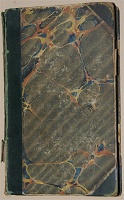 This fascinating 228 page work
(without any maps) is a concise and final version of Campbell's earlier
"Travels in South Africa". In this work Campbell
summarises much of his trip while keeping in all the important and relevant
pieces. The book was written by Campbell twenty years after his first visit,
and nearly the same period after his published work based on the journals
of his first trip were published. With this in mind it is clear that
Campbell would have had plenty of time to reflect on the fact and
fantasy reflected in the journals of his first trip.
This fascinating 228 page work
(without any maps) is a concise and final version of Campbell's earlier
"Travels in South Africa". In this work Campbell
summarises much of his trip while keeping in all the important and relevant
pieces. The book was written by Campbell twenty years after his first visit,
and nearly the same period after his published work based on the journals
of his first trip were published. With this in mind it is clear that
Campbell would have had plenty of time to reflect on the fact and
fantasy reflected in the journals of his first trip.
This extremely important and rare book, just six inches high by four inches across, has the same frontpiece image as the 1815 work but reflects the important variation from transcript of his journal to "abridged by the author". (This book is in fact far rarer than the earlier published works on his travels).
The context of the pages dealing with August 7th, the date Campbell had the historic meeting with the Griquas - at which time their name was changed - is perfectly summarised in this abridged version with one very significant point of difference.
NO REFERENCE TO ANY DISCUSSION WITH THE GRIQUAS ABOUT MINTING COINS THROUGH THE LONDON MISSIONARY SOCIETY.
Image right below: Frontpiece of the abridged "Journal of Travels in South Africa" carries the same image and similar format as the earlier (1815) transcribed journal of his travels. First edition (1834) undated on this page.
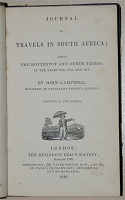 In
fact, the paragraph transcribed in the 1815 work at this
link is totally omitted by Campbell and is replaced by a subject
not covered in this earlier work. Campbell says, on pages 174 and 175:
In
fact, the paragraph transcribed in the 1815 work at this
link is totally omitted by Campbell and is replaced by a subject
not covered in this earlier work. Campbell says, on pages 174 and 175:
Many of the people have gardens; tobacco holds a distinguished place in them. It evidently is the favoured plant. Many acres of land in different parts of the country, especially around Griqua Town are cultivated. They abound in horned cattle, sheep and goats; and these, with other outward comforts, the people acknowledge, have considerably increased since they became a stationery people.
and
Regular trades cannot be said yet to exist in Griqualand.
The first paragraph discusses the basic level of farming that the Griquas had attained. The second statement is a reality check that flies in the face of the grandois ideals of minting coins - as transcribed from his journals in "Travels in South Africa". In fact it screams out as an admission by Campbell of his reporting fantasy as opposed to recording fact. This first edition edit by Campbell OMITS any reference to the Griquatown Coins. As reflected above and noted below Campbell was, by his own admission, a man who wrote with fervour - but often created an ideal in his writing without actually bringing it to fruition.
Though I have presented these Walks of Usefulness to the public , I have to confess, with shame, that they describe in many instances, what might have been done, rather than what, in many cases, I have really done.
NOTE: A transcript of the relevant pages of "Journal of Travel in South Africa" together with digital mages of the relevant pages can be seen at this link.
One copy of this extremely rare and valuable book, with slight discolouration on some pages and loose front board is held in the Balson Holdings Family Trust collection.
Critical comment on this work:Campbell's omission in this work abridged by him of any reference to discussions with the Griquas about minting coins and his comment, in its place that Regular trades cannot be said yet to exist in Griqualand spells out the fantasy of what he wrote in the transcribed journals in his earlier work. |

 Voyages to and
from the Cape of Good Hope with an account of a journey into the interior
of S Africa by Rev John Campbell
(1840)
Voyages to and
from the Cape of Good Hope with an account of a journey into the interior
of S Africa by Rev John Campbell
(1840)
Published for the Religious Tract Society, this 248 page book with several illustrations (some shown below) has a blind stamped cloth and gilt spine. (Illustrations sale as 1830 edition above).
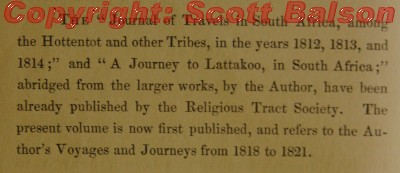
This 16cm by 10cm sized book is a condensed description of his second voyage to S. Africa, 1819-21 and is "intended for the young". The full account of his second voyage appeared in 2 vols. in 1822.
Interestingly the entire second trip to Griquatown is omitted from this edition of Campbell's book.
Publisher: In the 1830 edition (above it was the Philadelphia: Presbyterian Board of Publication, but in this 1840 edition is published by the Religious Tract Society with no reference to the Board. (See image of frontispiece below).
One copy of this extremely rare 1840 edition in very good is held in the Balson Holdings Family Trust collection. (No copies of this books are available for sale on the Internet).
 |
 |
Frontispiece |
Menu |
Critical comment on this work:A fascinating, fanciful but rare edited work of Campbell's second trip to South Africa. |


Six Letters on the Church Question
by Rev John Campbell
(1840)
These letters totalling 30 pages have been removed from a nonce volume are signed on the title page by the Rev John Campbell.
One of those amazing collectables whose history is now lost in time!
A unique item and extremely rare item held by the Balson Holdings Family Trust.
Critical comment on this work:Historically interesting but not related to his trips to Africa. |
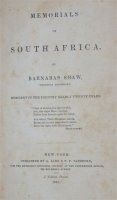

Memorials of South Africa
by Barnabus Shaw
(1841)
Account by a Wesleyan missionary which incorporates Christian observations and descriptions of the peoples and life of South Africa.. This is the First American Edition which was reproduced in 1970.
Fascinating insight into South Africa in the early days. You can see through the imbalance of white men to women how the seeds of the Griqua population were formed.
The information includes the number of white settlers in the colony in 1688:
A unique item and extremely rare item held by the Balson Holdings Family Trust.
Critical comment on this work:Historically interesting but not related to his trips to Africa. |
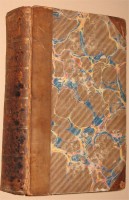

Evangelical Magazine
by Various
(1845)
The Missionary Magazine and Chronicle hardbound; Relating Chiefly to the Missions of various missionary societies including the London Missionary Society.
Contents include:
Critical comment on this work:A fascinating and rare work by the missionaries - the Bergenaar story is of special interest. |



Gospel among the Bechuanas
by Robert Moffat (1846 and 1885 editions)
This 300 page hard-covered first edition book, printed by the Philadelphia American Sunday School Union, used to be in the Library of the Colgate-Rochester Divinity School.
The book has been inscribed with the words Brethren "how shall they believe in him of whom they have not heard" and signed by Robert Moffat. (See image below).
The first edition 1846 edition dark cover seen right with later 1885 light cover. (Both books have the same number of pages but the later edition is slightly larger).
The book covers in some detail the work of Moffat on Jager Africaner and his brother Titus - both feared outlaws that the great missionary converted to God-fearing men.
This rare book in worn condition is held by the Balson Holdings Family Trust.
Cover of 1846 edition |
Book inscribed by Robert Moffat |
Plates |
from book |
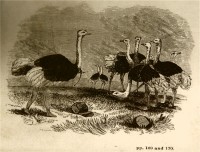 |
|||
Cover of 1885 edition |
The chapter on Africaner |
Critical comment on this work:A fascinating and rare work by Moffat looking at his work at Kuruman. |


Evangelical Magazine
by Various
(1846)
The Evangelical Magazine hardbound over 700 pages for the year 1846; carrying a variety of articles and feedback from mission around the world.
The book starts with the tragic death of Rev William Philip, son of the London Missionary Society's superintendent in S Africa Rev John Philip after whom Philippolis is named. William drowned in the Gamtoos river and was only found the next day.
Contents include:
This rare document is held by the Balson Holdings Family Trust .
Critical comment on this work:A fascinating and rare work by the missionaries - the Bergenaar story is of special interest. |
 The Kafir, the Hottentot and the Frontier Farmer
The Kafir, the Hottentot and the Frontier Farmer
passages of Missionary Life -
Archdeacon Nathaniel James Merriman (1853)
 Ppii + 216, black
and white and 3 coloured illustrations, folding map, mustard blind-stamped
cloth with gilt lettering.
Ppii + 216, black
and white and 3 coloured illustrations, folding map, mustard blind-stamped
cloth with gilt lettering.
The book, Merriman's 1850 diary, was published by the Bishop of Cape Town after Merriman's death.
It records in diary form the background to the Kat River rebellion by the Hottentots.
Merriman describes the Griquas of Griquatown and Philippolis on page 84 as being unable "to keep a shop; not from any deficiency or mathematical or inability to keep the books , but from the impossibility which they find in preventing their countrymen from getting into debt, or making them pay debts when they have contracted them. In fact, there is an universal prevelance of social dishonesty among them, and almost as universal a prevelance of the questionable quality of a "good nature", so called, that they cannot say "no" to a begging idler or fellow countryman."
Two copies of this rare book in excellent condition are held by the Balson Holdings Family Trust.
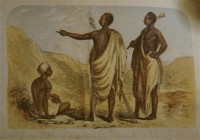 |
|||
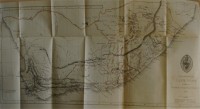 |
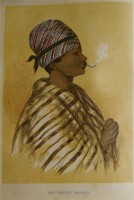 |
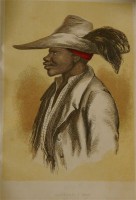 |
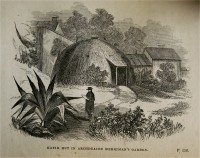 |
Critical comment on this work:Fascinating first hand account of the lives of the Griquas |
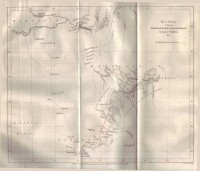 Visit to Moselekatse, King of the Matabele -
Visit to Moselekatse, King of the Matabele -
 This rare document
numbering over 20 pages is taken from a magazine and includes the map seen
right.
This rare document
numbering over 20 pages is taken from a magazine and includes the map seen
right.
The document is bound in a contemporary blue card cover and is very rare.
The document is Moffat's diary of his visit north of the Limpopo to meet Moselekatse and includes his failed attempt to find Dr Livingstone to the north.
The document gives a rare insight to how highly regarded Moffat was amongst African tribes - including those hundreds of miles from Kuruman, where his mission station was based.
This rare document is held by the Balson Holdings Family Trust .
Critical comment on this work:A very valuable resource in which Moffat graphically describes the hardships faced in travelling into the darkest parts of Africa. |
 1857 Missionary Chronicle Magazine -
1857 Missionary Chronicle Magazine -
 This rare magazine,
numbering 800 pages, covers the worldwide exploits of missionaries from the
London Missionary Society.
This rare magazine,
numbering 800 pages, covers the worldwide exploits of missionaries from the
London Missionary Society.
The book is just 6 inches by 9 inches and both covering boards have become detached. The book contains several interesting plates including the one of Dr Livingstone below.
Articles include:
This rare book is held by the Balson Holdings Family Trust .
Critical comment on this work:An interesting work even if the LMS does create a fair degree of self-glorification. |
 Notes on the Holy Bible -
Notes on the Holy Bible -
 This rare hard covered book (A5 size) is published by
Glasgow: W. R. M'Phun & Son, 1857.
This rare hard covered book (A5 size) is published by
Glasgow: W. R. M'Phun & Son, 1857.
Blindstamped brown leather covers with fleur de lys and scroll patterning and blind rules. Spine has five raised bands with further stamping, five inverted gilt leaves and title in gilt. Wear to hinges. All edges are gilt and there are thick gilt dentelles and a tissue guarded frontispiece of the Rev. Campbell. The Bible contains a number of line coloured maps and to the rear is a set of Standard Psalm Tunes sung in Scotland and blank four stave music and the Hymns, the Psalms of David and a Biblical Cyclopaedia. Some handling marks.. Full-Leather. Very Good. 12mo - over 6!" - 7!" tall. , Publisher: W. R. M'Phun & Son
This rare book is held by the Balson Holdings Family Trust .
Critical comment on this work:An interesting and extremely rare work by Rev John Campbell - not found on the web. |
 Missionary travels and researches in South Africa -
Dr David Livingstone
Missionary travels and researches in South Africa -
Dr David Livingstone
 Anyone who knows
anything about Africa knows that famous statement between Stanley and Livingstone
"Dr Livingstone I presume?" made when they met for the first time
in the wilds of darkest Africa - allegedly near what is now known as Victoria
Falls on the Zambesi river.
Anyone who knows
anything about Africa knows that famous statement between Stanley and Livingstone
"Dr Livingstone I presume?" made when they met for the first time
in the wilds of darkest Africa - allegedly near what is now known as Victoria
Falls on the Zambesi river.
It was Livingstone who met the resident missionary of Griqua Town, Robert Moffat's daughter, and married her forging a bond between two great missionary groups. Livingstone describes his meeting with Moffat in Griqua Town, the people, the
The book comes with pull out maps and fascinating drawings of people, scenery and animals recorded by the great man.
See also this link with more on Livingstone's travels through the Missionary Magazines
This rare first edition copy held by the Balson Holdings Family Trust has been signed by Dr Livingstone (see below) - the BHFT also holds an unsigned copy (1858 American edition) and has transcribed the entire book onto the web at this link.
Critical comment on this work:What can I say? You don't have to have a special interest in the Griquas to want to read this fascinating diary of events by one of the world's best known explorers. |
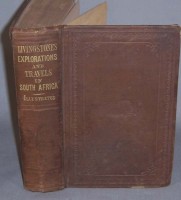 Livingstone's Explorations in South Africa - Dr
David Livingstone
Livingstone's Explorations in South Africa - Dr
David Livingstone
 The complete title
of this book is "Livingstone's Explorations and Travels in South
Africa".
The complete title
of this book is "Livingstone's Explorations and Travels in South
Africa".
This book is dated 1858 and is a first edition. The book measures 5 1/4 by 7 3/4 inches and contains 446 pages of text and then several pages of books published by J W Bradley. The binding is tight and the book is in good condition. There are pencil scribble marks all the way in the back. The very back page is torn. There is no text on that page. There are also names written in the front of the book. There is foxing throughout the book and several illustrations.
This rare first edition copy held by the Balson Holdings Family Trust is in good condition.
Images in the book |
Critical comment on this work:Another remarkable work detailing life in darkest Africa be the world's most famous African Missionary. |